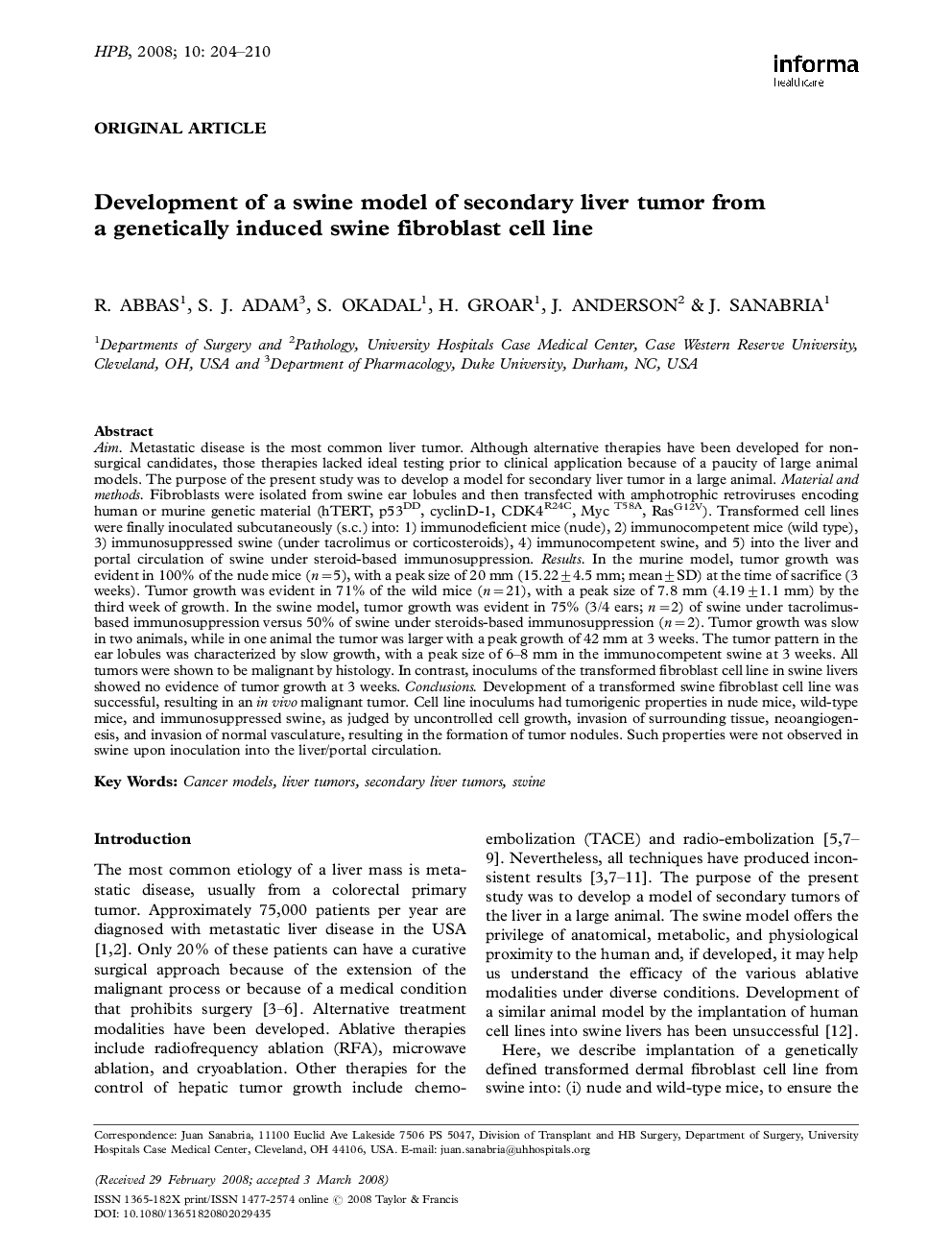| کد مقاله | کد نشریه | سال انتشار | مقاله انگلیسی | نسخه تمام متن |
|---|---|---|---|---|
| 3270188 | 1208203 | 2008 | 7 صفحه PDF | دانلود رایگان |
عنوان انگلیسی مقاله ISI
Development of a swine model of secondary liver tumor from a genetically induced swine fibroblast cell line
دانلود مقاله + سفارش ترجمه
دانلود مقاله ISI انگلیسی
رایگان برای ایرانیان
موضوعات مرتبط
علوم پزشکی و سلامت
پزشکی و دندانپزشکی
غدد درون ریز، دیابت و متابولیسم
پیش نمایش صفحه اول مقاله

چکیده انگلیسی
Aim. Metastatic disease is the most common liver tumor. Although alternative therapies have been developed for non-surgical candidates, those therapies lacked ideal testing prior to clinical application because of a paucity of large animal models. The purpose of the present study was to develop a model for secondary liver tumor in a large animal. Material and methods. Fibroblasts were isolated from swine ear lobules and then transfected with amphotrophic retroviruses encoding human or murine genetic material (hTERT, p53DD, cyclinD-1, CDK4R24C, Myc T58A, RasG12V). Transformed cell lines were finally inoculated subcutaneously (s.c.) into: 1) immunodeficient mice (nude), 2) immunocompetent mice (wild type), 3) immunosuppressed swine (under tacrolimus or corticosteroids), 4) immunocompetent swine, and 5) into the liver and portal circulation of swine under steroid-based immunosuppression. Results. In the murine model, tumor growth was evident in 100% of the nude mice (n=5), with a peak size of 20 mm (15.22±4.5 mm; mean±SD) at the time of sacrifice (3 weeks). Tumor growth was evident in 71% of the wild mice (n=21), with a peak size of 7.8 mm (4.19±1.1 mm) by the third week of growth. In the swine model, tumor growth was evident in 75% (3/4 ears; n=2) of swine under tacrolimus-based immunosuppression versus 50% of swine under steroids-based immunosuppression (n=2). Tumor growth was slow in two animals, while in one animal the tumor was larger with a peak growth of 42 mm at 3 weeks. The tumor pattern in the ear lobules was characterized by slow growth, with a peak size of 6-8 mm in the immunocompetent swine at 3 weeks. All tumors were shown to be malignant by histology. In contrast, inoculums of the transformed fibroblast cell line in swine livers showed no evidence of tumor growth at 3 weeks. Conclusions. Development of a transformed swine fibroblast cell line was successful, resulting in an in vivo malignant tumor. Cell line inoculums had tumorigenic properties in nude mice, wild-type mice, and immunosuppressed swine, as judged by uncontrolled cell growth, invasion of surrounding tissue, neoangiogenesis, and invasion of normal vasculature, resulting in the formation of tumor nodules. Such properties were not observed in swine upon inoculation into the liver/portal circulation.
ناشر
Database: Elsevier - ScienceDirect (ساینس دایرکت)
Journal: HPB - Volume 10, Issue 3, June 2008, Pages 204-210
Journal: HPB - Volume 10, Issue 3, June 2008, Pages 204-210
نویسندگان
R. Abbas, S.J. Adam, S. Okadal, H. Groar, J. Anderson, J. Sanabria,